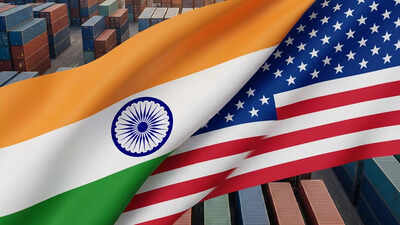India-US Trade Deal: Building Stability and Shared Benefits

India is keen on understanding how the US plans to reduce duties. (AI image)
India and the US are actively working to complete the first phase of their trade deal. India is seeking assurance that the US will not impose additional tariffs after the deal is finalized.
On April 2, US President Donald Trump announced a 26% tariff on Indian goods as part of a global trade measure. These tariffs were postponed for 90 days until July 9. Both countries are striving to conclude the trade deal before this deadline.
India Awaits Assurances from the US
India is looking for a commitment from the US that no further tariffs will be added once the trade deal is in place. The negotiations are nearing completion, and both sides are optimistic about reaching a swift agreement.
India has requested benefits for sectors that employ a large number of people, such as leather and textiles. “We have presented all our requests,” a source told ET, indicating India’s push for stable tariffs post-deal.
Trade experts concur that such a guarantee is crucial. “The trade deal should have a time limit,” a trade policy expert stated. “India must push for a clawback provision, allowing it to withdraw benefits if the US raises tariffs or fails to keep its promises.”
Indian officials have emphasized that the US needs to find a way to reduce tariffs. India has sought concessions for industries like textiles and leather.
India’s Concerns Regarding the Trade Deal
- India is concerned about how the US will reduce duties. The absence of US Fast Track Trade Authority could delay the trade deal.
- The US Fast Track Trade Authority enables the President to negotiate trade deals and present them to Congress for a straightforward vote, without amendments or delays.
- An Indian official mentioned that it’s up to the US to determine how to manage their domestic regulations.
- Both countries are considering a unique selection of products under the proposed deal. India wants lower duties for its labor-intensive goods. In exchange, India is offering concessions on US cars and certain farm products. Both nations aim to finalize the trade deal by September-October.
- The US is also examining the impact of 50% duties on steel and aluminum, and 25% duties on cars. While the car parts industry anticipates minimal immediate impact, long-term tariffs could affect the sector. India plans to request concessions if they are granted to other countries.
Early Trade Deal in the Works?
The Indian government is eager to secure the initial part of the trade deal with the US before July 9. India is pursuing “preferential and sustained advantage” through mutual duty reductions.
“To double trade to $500 billion, both sides need to reduce tariffs for improved market access. It should be the goal of both countries to lower the tariffs. How much they can do so legally depends on their trade outlook,” a senior official told TOI.
“We are focusing on the early part of the deal and, as you know, there is a date (July 9). We would like to conclude this early part before that,” Commerce Secretary Sunil Barthwal said.



